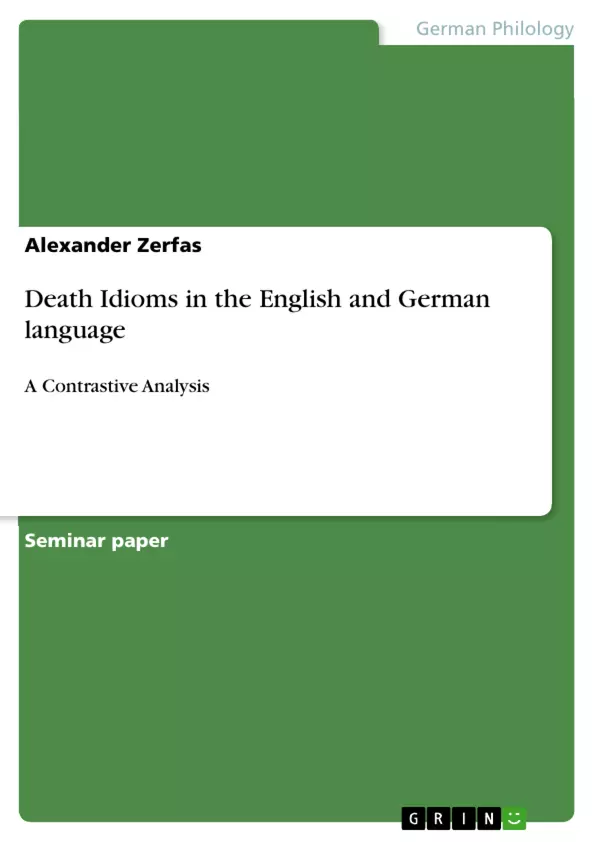This paper consists of two major parts, a theoretical framework and a contrastive analysis of idioms of death in the English and German language. The first part deals with the linguistic definition of the term “idiom”, including possibilities for their classification. The second section of the first part is going to present the concept of euphemism followed by a brief explanation and categorization of metaphors and the attempt of giving possible reasons for the maintaining taboo of death in western culture. The purpose of the second part of this paper is to analyze and compare a number of English and German idioms of death contrastively, in order to identify lexical and semantic similarities, including the investigation of the origin of certain expressions. Subsequently, a short closing reflection will end up this paper.
As death plays a significant role not only in western society but in communities all around the globe, idioms related to death became an important tool in human communication. But what is the actual purpose of using paraphrases in order to relate to death in an utterance? Why do idioms of death have a cultural importance and how is an idiom actually defined? Do certain idioms of death have the same semantic meaning in other languages?
Human communication has created a great number of idioms and figures of speech which range throughout every section of the daily life and appear in every situation possible. As this phenomenon indeed shows its importance, linguists have created the field of phraseology to investigate such expressions. Based on language contact and historical events, many idioms have synonyms and equivalent counterparts in several languages. Learning the specific idioms related to a certain culture helps to get to know more about the history, ethics and social values of a certain community.
Table of Contents
- Introduction
- Definition and Importance of Idioms
- Classifications of Idioms
- Euphemism and Taboo
- Metaphors
- Reasons for the Tabooing of Death
- Analysis of idioms of Death in English and German
- Closing Reflection
Objectives and Key Themes
This paper aims to provide a contrastive analysis of death idioms in the English and German languages. It explores the linguistic definition of idioms, their classification, and the concept of euphemism and metaphor. The paper also examines the reasons behind the tabooing of death in Western culture.
- The definition and importance of idioms
- The classification of idioms
- The concept of euphemism and taboo
- The role of metaphors in death idioms
- A comparative analysis of death idioms in English and German
Chapter Summaries
- Introduction: This chapter introduces the topic of idioms and their significance in human communication. It highlights the importance of idioms in understanding cultural contexts and their role in figurative speech.
- Definition and Importance of Idioms: This chapter provides a detailed definition of idioms and discusses their various classifications. It explores the origins of idioms and their unique role in language and culture.
- Classifications of Idioms: This chapter delves into different classifications of idioms, including those based on topic, semantic relationship, and morphological structure. It examines various approaches to categorizing idioms, such as those based on encoding, decoding, and lexical and sememic levels.
- Euphemism and Taboo: This chapter explores the concept of euphemism in relation to death idioms. It analyzes how euphemisms function as a means of avoiding direct references to death and the cultural reasons behind this practice.
- Metaphors: This chapter examines the role of metaphors in death idioms. It discusses how metaphors contribute to the figurative meaning of idioms and their cultural significance.
- Reasons for the Tabooing of Death: This chapter examines the cultural and psychological reasons behind the tabooing of death in Western society. It explores how this taboo influences the use of death idioms and their linguistic expressions.
Keywords
This paper focuses on the analysis of idioms related to death in English and German, exploring concepts like euphemism, metaphor, and the cultural taboo surrounding death. It examines the classifications of idioms, their linguistic features, and their role in communication and cultural understanding. Key terms include idioms, figurative speech, death idioms, euphemisms, metaphors, cultural taboo, contrastive analysis, English language, German language.
- Quote paper
- Alexander Zerfas (Author), 2014, Death Idioms in the English and German language, Munich, GRIN Verlag, https://www.grin.com/document/372224



